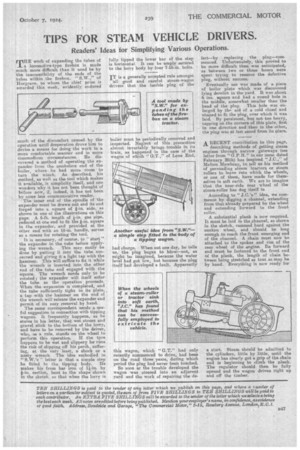TIPS FOR STEAM VEHICLE DRIVERS.
Page 29

If you've noticed an error in this article please click here to report it so we can fix it.
Readers' Ideas for Simplifying Various Operations.
MITE work of expanding the tubes of 1 a locomotive-type firebox is made much snore difficult than it need be by the inaccessibility of the ends of the tubes within the firebox. " S.W.," of Korgrave, to whom the chief prize is awarded this week, evidently endured much of the discomfort caused by the operation until desperation drove him to devise a means for doing the work in a more comfortable manner and in more commodious circumstances. He discovered a method of operating the expander from the smokebox end of the boiler, where he had more room to turn the winch. As described, his method, as well as the tool which makes it available, is simplicity itself, and one wonders -why it has not been thought of before now, if, indeed, it has not been by some less communicative reader.
The inner end of the spindle of "the expander must be drawn out and its end forged into a square of fin, side, as shown in one of the illustrations on this page. A 6-ft. length of gas pipe, reduced at one end to fit the fin, square in the expander, and provided at the other end with an 18-in, handle, serves as a means for rotating the tool.
It is necessary, of course, to "start 's the expander in the tube before applying the wrench. This may easily be done by putting it into the tube concerned and giving it a light tap with the hammer. This will suffice to fax it, while the wrench is inserted into the other end of the tube and engaged with the square. The wrench needs only to be rotated • the expander will itself enter the tube as the operation proceeds. When the expansion is completed, and the tube sufficiently tight in its plate, . a tap with the hammer on the end of the wrench will release the expander and permit of its easy removal by hand.
The same correspondent sends a useful suggestion in connection with tipping wagons. It frequently happens, as he states in his letter, that wet stones and gravel stick to the bottom of the lorry, and have to be removed by the driver, who, as a rule, stands on the wheel to perform this operation. If the tyre happens to be wet and slippery he runs the risk of slipping off his perch, suffering, at the very least, a shock or a nasty wrench. The idea embodied in letter is that a simple step be fitted to the tipping body. He
makes his from bar iron of by isin. section, bent to the shapeshown in the sketch, so that when the lorry is
fully tipped the lower bar of the step is horizontal. It can be amply secured to the lorry body by four 7-16-in, bolts.
fr is a generally accepted rule amongst all good and careful steam-wagon drivers that the fusible plug of the
boiler must be periodically removed and inspected. Neglect of this precaution almost invariably brings trouble in its train, as happened in the case of the wagon of which `.` G.T.," of Lane End, had charge. When out one day, he tells us, the plug began to blow—not, as might be imagined, because the water level had got low, but because the plug itself had developed a fault. Apparently this wagon, which " G.T." had only recently commenced to drive, had been on the road three years, during which period the plug had never been touched.
So soon as the trouble developed the wagon was steered into an adjacent yard and the work of repairing the de
feet—by replacing the plug—corn. xnenced. Unfortunately, this proved to be more difficult than was anticipated, as between two or three hours were spent trying to remove the defective plug, without success.
Eventually use was made of a piece of boiler plate which was discovered lying derelict in the yard. It was about 6 ins, square and had a round hole in the middle, somewhat smaller than the head of the plug. This hole was enlarged by the aid of a cold chisel and shaped to fit the plug, over which it was laid. By persistent, but not too heavy, tapping on the corners of this plate, first in one direction and then in the other, the plug was at last eased from its place.
A RECENT contribution to this page,
describing methods of getting steam engines through narrow gateways (see letter from " G.P.H." in our issue dated February 26th) has inspired "J.C.," of Melton Mowbray, to tell us his method of persuading steam tractors or steam rollers to leave ruts which the wheels, or one of them, have made for themselves in soft earth. We are to imagine that the near-side rear wheel of the steam-roller has dug itself in According to "J.C.'s" idea, we cornmence by digging a channel, extending from that already prepared by the wheel and extending forward to the front roller.
A substantial plank is now required. It must be laid in the channel, as shown in the sketch, rammed hard against the sunken wheel, and should be long enough to reach the front emerging end of the channel_ A chain must now be attached to the spokes and rim of the rear wheel of the engine. Its forward end must be fastened to the front end of the plank, the length of chain between being stretched as taut as may be by hand. Everything is now ready for
a start. Steam should be admitted to the cylinders, little by little, until the engine has clearly got a grip of the chain and is beginning to climb the plank. The regulator should then be fully opened and the wagon driven right up and off the timber.






























